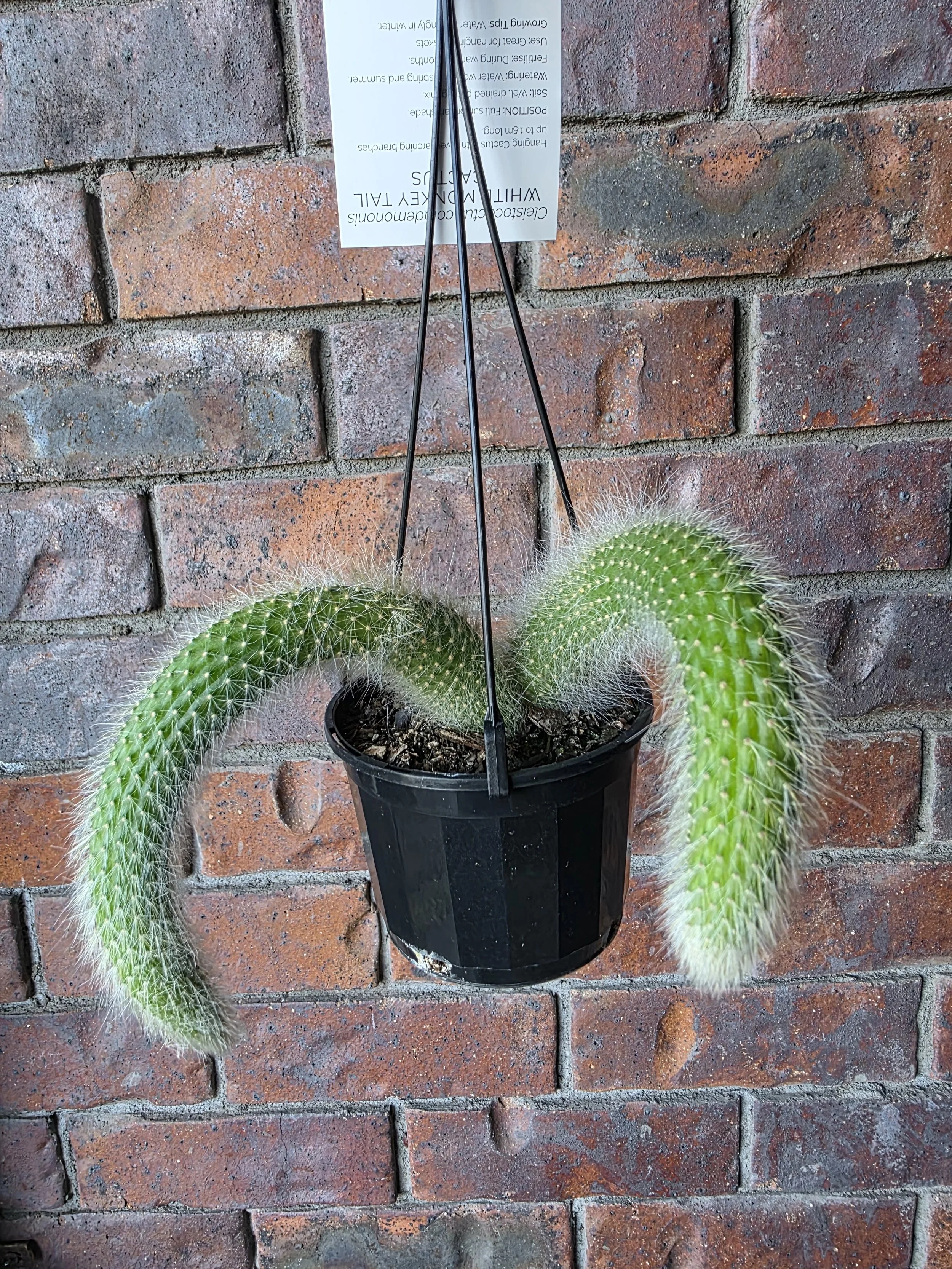 Image 1 of 1
Image 1 of 1


Monkey Tail White
🌵 Monkey Tail Cactus – White Form
Scientific Name: Cleistocactus colademononis
Common Names: Monkey Tail Cactus, White Monkey Tail, Cola de Mono
Family: Cactaceae
Origin: Bolivia, particularly the Santa Cruz region at high elevations
📏 Physical Description
Growth Habit:
A trailing or cascading cactus with long, soft, tail-like stems that can reach up to 2.5 meters (8 feet) in length.
Perfect for hanging baskets, where its long stems can hang dramatically over the edge.Stems:
Cylindrical and about 2–4 cm thick, densely covered in long, white, silky hairs giving the appearance of a monkey’s tail.
The white form is notable for its thicker and brighter white hair coverage, compared to the standard greenish-yellow form.Spines:
Beneath the hairs are soft, golden to white radial spines, but these are usually hidden and non-prickly in feel.
🌸 Flowers
Appearance:
Produces stunning bright red to magenta tubular flowers, typically 6–8 cm long, along the upper parts of the stems.
Blooms occur mainly in spring and summer, even on younger plants in ideal conditions.Pollination:
Attracts hummingbirds (in the wild) and insects.
🌱 Care and Cultivation
Light:
Prefers bright light to full sun—ideally morning sun or filtered light in very hot areas.
Indoors, place near a south- or east-facing window.Watering:
Water deeply during the growing season (spring to summer), allowing the soil to dry between waterings.
In winter, reduce watering to prevent root rot.Soil:
Requires a well-draining cactus mix—add pumice, sand, or perlite to enhance drainage.Temperature:
Thrives in warm conditions. Ideal range: 18–30°C (64–86°F).
Tolerates light frost down to -2°C (28°F) if kept dry, but best brought under cover in cold or wet climates.Feeding:
Apply a diluted cactus fertilizer monthly during active growth (spring–early autumn).Propagation:
Easily propagated from stem cuttings—allow to callous over for several days before planting in dry mix.
✅ Quick Care Summary
RequirementDetailsLightBright light to full sunWaterLet soil dry between wateringsSoilVery well-draining cactus mixTemperature18–30°C ideal; protect from heavy frostFeedingMonthly during growing seasonGrowth HabitCascading stems, up to 2.5 m longFlowering TimeSpring to early summer
✅ Uses
Perfect for hanging baskets, wall planters, or tall pots where stems can cascade freely
Striking as a specimen plant for succulent collectors or modern interiors
Ideal for greenhouses, bright patios, or arid-themed garden beds
⚠️ Common Issues
Root rot: Most common issue—avoid overwatering and ensure excellent drainage
Sunburn: Too much intense direct sun (especially in pots) can scorch hairs and skin
Pests: Rare but can get mealybugs or spider mites—treat early with insecticidal soap
🪴 Display Tip for Brisbane:
Hang your White Monkey Tail in a bright outdoor patio or under a pergola—its white, hairy stems will catch the light beautifully and contrast well with colorful bromeliads, string succulents, or euphorbias.
🌵 Monkey Tail Cactus – White Form
Scientific Name: Cleistocactus colademononis
Common Names: Monkey Tail Cactus, White Monkey Tail, Cola de Mono
Family: Cactaceae
Origin: Bolivia, particularly the Santa Cruz region at high elevations
📏 Physical Description
Growth Habit:
A trailing or cascading cactus with long, soft, tail-like stems that can reach up to 2.5 meters (8 feet) in length.
Perfect for hanging baskets, where its long stems can hang dramatically over the edge.Stems:
Cylindrical and about 2–4 cm thick, densely covered in long, white, silky hairs giving the appearance of a monkey’s tail.
The white form is notable for its thicker and brighter white hair coverage, compared to the standard greenish-yellow form.Spines:
Beneath the hairs are soft, golden to white radial spines, but these are usually hidden and non-prickly in feel.
🌸 Flowers
Appearance:
Produces stunning bright red to magenta tubular flowers, typically 6–8 cm long, along the upper parts of the stems.
Blooms occur mainly in spring and summer, even on younger plants in ideal conditions.Pollination:
Attracts hummingbirds (in the wild) and insects.
🌱 Care and Cultivation
Light:
Prefers bright light to full sun—ideally morning sun or filtered light in very hot areas.
Indoors, place near a south- or east-facing window.Watering:
Water deeply during the growing season (spring to summer), allowing the soil to dry between waterings.
In winter, reduce watering to prevent root rot.Soil:
Requires a well-draining cactus mix—add pumice, sand, or perlite to enhance drainage.Temperature:
Thrives in warm conditions. Ideal range: 18–30°C (64–86°F).
Tolerates light frost down to -2°C (28°F) if kept dry, but best brought under cover in cold or wet climates.Feeding:
Apply a diluted cactus fertilizer monthly during active growth (spring–early autumn).Propagation:
Easily propagated from stem cuttings—allow to callous over for several days before planting in dry mix.
✅ Quick Care Summary
RequirementDetailsLightBright light to full sunWaterLet soil dry between wateringsSoilVery well-draining cactus mixTemperature18–30°C ideal; protect from heavy frostFeedingMonthly during growing seasonGrowth HabitCascading stems, up to 2.5 m longFlowering TimeSpring to early summer
✅ Uses
Perfect for hanging baskets, wall planters, or tall pots where stems can cascade freely
Striking as a specimen plant for succulent collectors or modern interiors
Ideal for greenhouses, bright patios, or arid-themed garden beds
⚠️ Common Issues
Root rot: Most common issue—avoid overwatering and ensure excellent drainage
Sunburn: Too much intense direct sun (especially in pots) can scorch hairs and skin
Pests: Rare but can get mealybugs or spider mites—treat early with insecticidal soap
🪴 Display Tip for Brisbane:
Hang your White Monkey Tail in a bright outdoor patio or under a pergola—its white, hairy stems will catch the light beautifully and contrast well with colorful bromeliads, string succulents, or euphorbias.